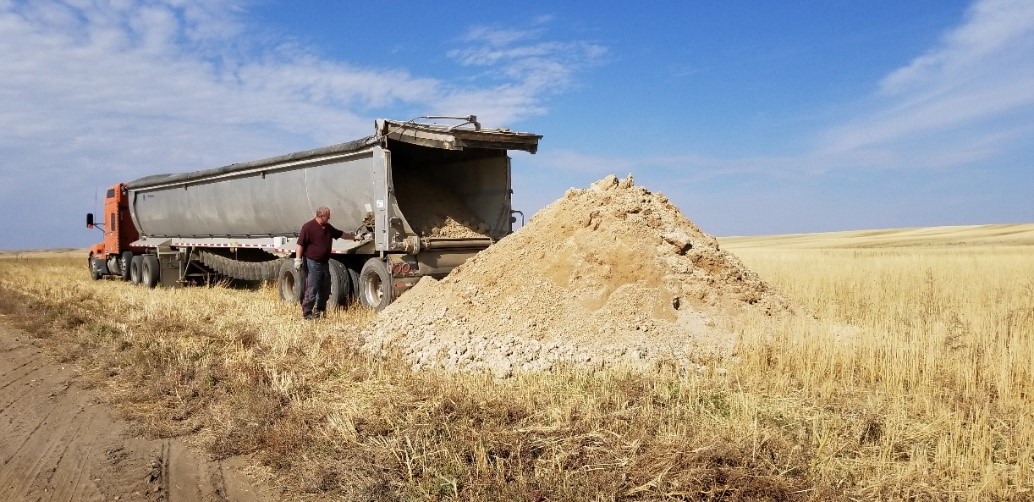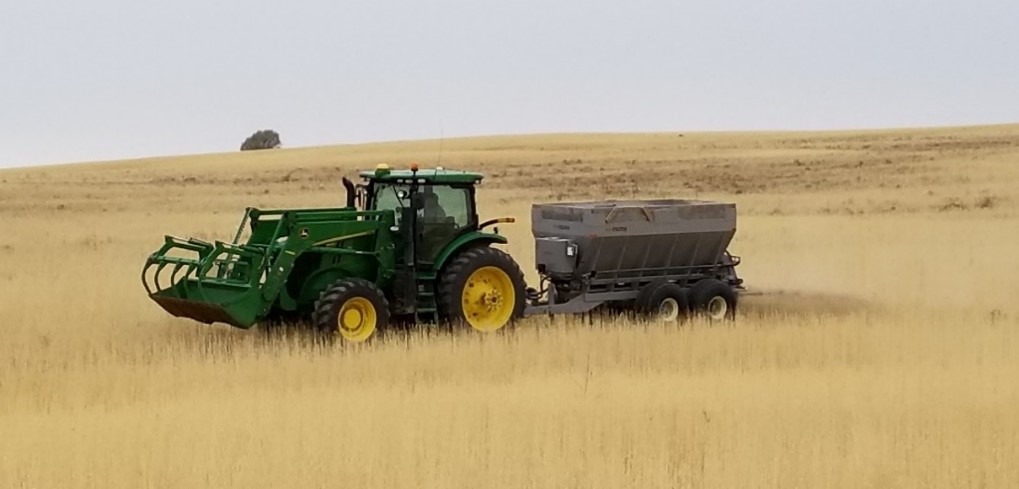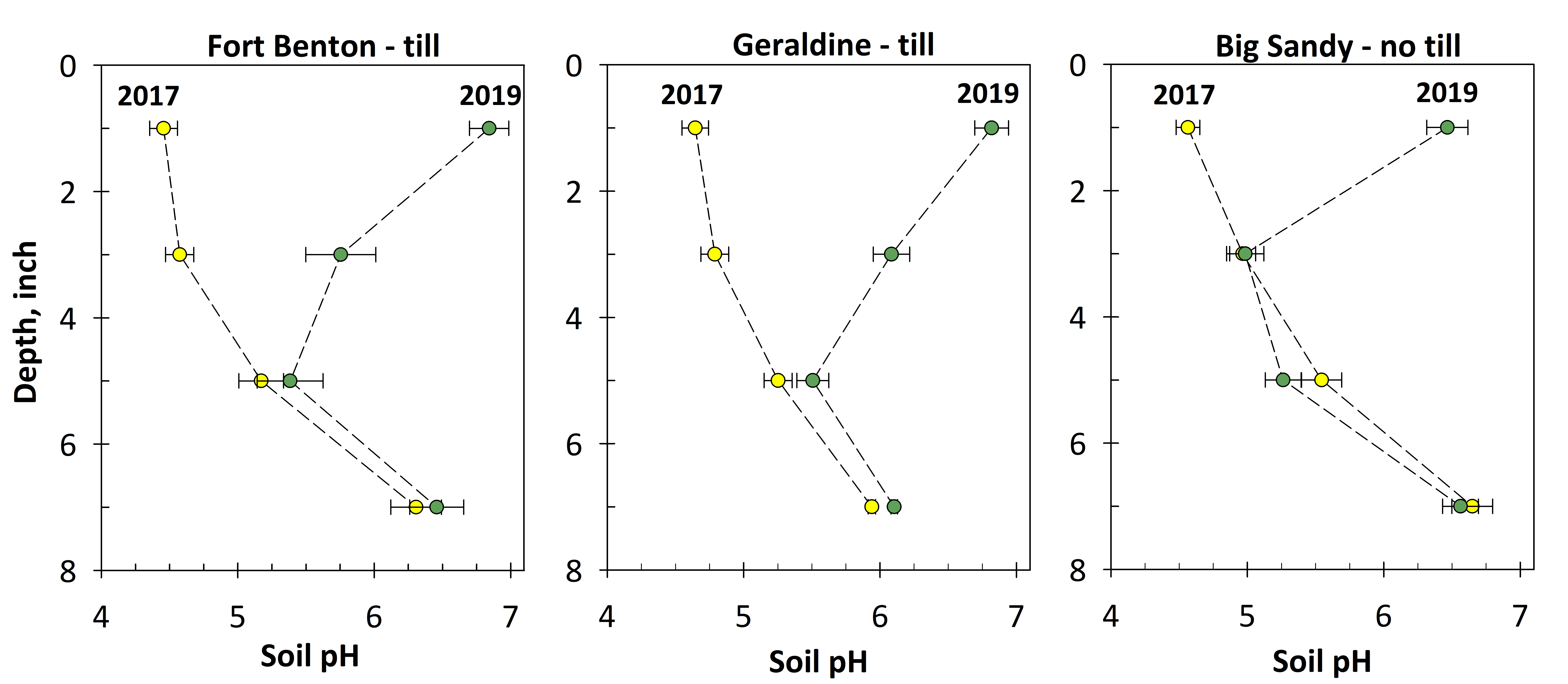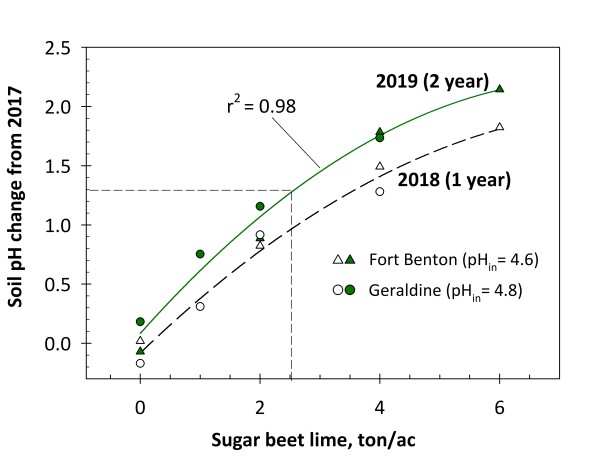Soil Acidification: Remediation with Sugar Beet Lime
by Richard Engel, Clain Jones, and Rosie Wallander
Land Resources and Environmental Sciences, MSU, Bozeman.
INTRODUCTION
Soil acidification of surface layers (0-6 inch) is becoming a major problem for some croplands in Montana. Historically, problems associated with soil acidity have been virtually unknown in our state because most cultivated soils were neutral (pH near 7) to alkaline (pH > 7). Over the past 40 years, Montana has experienced a tremendous growth in nitrogen (N) fertilizer use that has accelerated the rate of soil acidification. Fertilizer-N is sold almost entirely in the “ammoniacal” form (including urea), meaning it contains ammonium (NH4+) or quickly becomes ammonium. In the soil, ammonium undergoes microbial oxidation (nitrification) to produce nitrate (NO3-) and acid (H+).
Ammonium+ Oxygen → Nitrate + Water + Acid
Over time, soil pH falls and the rate at which acidity develops is strongly related to cumulative fertilizer-N application rates.
Acidification has a dramatic impact on soil chemical and microbial processes. Aluminum from soil minerals becomes more soluble as pH falls below 5 which can lead to aluminum toxicity in crops and longer carryover of some herbicides. Rhizobia growth, survival and abundance, and nodulation (which is responsible for N fixation by legumes) of pulse and other legume crops decrease as pH falls below 6. These processes can greatly reduce crop growth and production, and require remediation with the application of liming materials. Sugar beet lime (sometimes referred to as spent lime, hereafter referred to as beet lime), is a byproduct of the raw sugar purification process. The product is currently available for free at beet processing plants in Billings and Sidney. However, shipping and application costs can be substantial given that high rates of lime are generally needed to change soil pH. We conducted this study to evaluate the efficacy and economics of beet lime to remediate soil pH.
METHODS
We conducted on-farm beet lime strip-trials at three locations in Chouteau County (northwest of Big Sandy, south of Fort Benton, and north of Geraldine). The Fort Benton and Geraldine trials were under continuous crop management and the Big Sandy trial was under a fallow-crop system. Each trial consisted of eight strips with three beet lime rates, i.e., 0, 1, 2- and 4-ton/acre at Big Sandy and Geraldine, and 0, 2, 4, and 6-ton/acre at Fort Benton. The 0 and 4 ton/acre rates were replicated three times in a randomized complete block design.
The beet lime was trucked from the Western Sugar Cooperative in Billings to the field locations (Figure 1A). Beet lime contains about 53-57% calcium carbonate (CaCO3), 8-11% organic matter (beet impurities), and 30% water. Beet lime was applied to each field site in the fall of 2017 using a Stoltzfus wet lime applicator (Figure 1B) and incorporated with tillage (4-5 inches) at Fort Benton (beavertail spike and harrow) and Geraldine (Krause tandem disc harrow), but not at Big Sandy (left on surface). Individual limed strips were narrow and long (60 feet wide, 0.3 to 0.5 mile long) to include natural variation in terrain and/or soil pH that occurred across the field sites.


The dominant soil series at Big Sandy was a Telstad loam, and at Fort Benton and Geraldine a Bearpaw-Vida clay loam. Soil pH (0-4 inch) at Big Sandy, Fort Benton and Geraldine prior to beet lime application averaged 4.9, 4.6, and 4.8, respectively, but was highly variable across each field.
RESULTS
Soil pH change
Prior to application of beet lime (fall 2017), there was a large gradient in soil pH with depth. The most acidic soil layers were near the surface (Figure 2). Surface soils are more acidic because that is where fertilizer-N is applied and nitrifies. In fall 2019 (2-years after application), soil pH was much higher in the 0-2 inch layer (all locations) and moderately higher in the 2-4 inch soil layer than pre-liming pH only at Fort Benton and Geraldine but not changed at Big Sandy (Figure 2). These results were not surprising as beet lime was incorporated with tillage at Geraldine and Fort Benton, while at Big Sandy it was not incorporated. Beet lime does not wash into the soil even after two years if left on the surface, therefore, incorporation with tillage is necessary to correct soil acidity in Montana’s semiarid climate. No-till farmers may wonder about the impact of a single tillage on soil organic matter or soil organic carbon. We measured soil organic carbon content before and after tillage at Fort Benton and Geraldine (Table 1). The tillage to incorporate beet lime did not change soil organic carbon, which is consistent with studies in Wyoming (Bista et al. 2015) and Saskatchewan (Baan et al. 2009).
We found beet lime applications at Fort Benton and Geraldine raised soil pH (0-4 inch) over 1 and 2 years (Figure 3). Most of the pH changes occurred during the 1st year after the beet lime was incorporated with tillage.

Figure 2. Soil pH depth-profile before (Fall 2017) and two years after (Fall 2019) beet lime application (4 tons/acre) at Fort Benton (till), Geraldine (till), and Big Sandy (no-till).
|
|
Fort Benton
|
Geraldine
|
||
|---|---|---|---|---|
|
Depth (inch)
|
SOC-2017 (%) |
SOC-2018 (%)
|
SOC-2017 (%)
|
SOC-2018 (%)
|
|
0-2
|
2.26
|
2.26
|
1.37
|
1.38
|
|
2-4
|
1.41
|
1.68
|
0.95
|
1.03
|
|
4-6
|
1.15
|
1.17
|
0.83
|
0.81
|
|
6-8
|
1.14
|
1.10
|
0.79
|
0.76
|
|
† SOC values in this table are averages based on soil cores collected from 18 and 24 locations at the Fort Benton and Geraldine field sites, respectively. |
||||

|
Figure 3. Soil pH change in top 4 inches at 1-year (2018), and 2-year (2019) after application of beet lime, and beet lime requirements to change soil pH to a targeted level. pHin = the initial soil pH in 2017 before lime was applied, dashed lines show 2.5 ton lime/ac to reach pH 6.0. |
Lime rates and economics
At Fort Benton and Geraldine we needed 2.5 tons beet lime/acre to raise soil pH 1.3 units (to pH 6.0; Figure 3). The beet lime product used in our experiments contained approximately 55% CaCO3. (wet-weight basis). Hence, a lower application rate (i.e. 1.4 tons/acre) would be required for commercially available calcitic Aglime sources that are moisture free and contain 95-98% CaCO3.
It cost $35/ton to transport the beet lime to our farms in Chouteau County. The application plus tillage incorporation costs were estimated at $12/acre. Therefore, the total cost for soil remediation to a target pH 6.0 is $100/acre (2.5 x $35 + $12). Although this represents a considerable investment, the costs are modest when viewed over the long-term. Our research on long-term studies suggests that soils limed to pH 6.0 will not experience acidity related production problems for 15-20 years at typical N rates on wheat, or longer if crop rotations include pulses and amount of N fertilizer is reduced. This means annual costs of around $5 to $7/acre per year. Estimated cost inputs to change or increase soil pH to other target levels are provided in Table 2.
Our estimates are based on the knowledge that although fertilizer-N applications lead to lower soil pH levels, the acidification process occurs slowly over time and is strongly related to the cumulative amount of fertilizer-N applied. For example, a 14-yr study in Montana on a silt loam soil found that approximately 2200 lb/acre of fertilizer-N were required to lower pH 1.0 unit. The pH drop was faster on a sandy loam, yet cumulative N rates were much lower due to lower yield potential.
Table 2. Beet lime requirement and estimated cost inputs based on desired soil pH increase from pH 4.7 (average of Fort Benton and Geraldine field sites).
|
Soil pH increase desired
|
Beet lime requirement (ton/ac)
|
Estimated cost† ($/ac)
|
|---|---|---|
|
1.0
|
1.8
|
75
|
|
1.2
|
2.3
|
93
|
|
1.3
|
2.5
|
100
|
|
1.4
|
2.8
|
110
|
|
1.6
|
3.5
|
135
|
|
1.8
|
4.2
|
159
|
|
2.0
|
5.0
|
187
|
|
† Cost inputs are based on a transport of $35/ton of beet lime material + application plus tillage incorporation at $12/acre. |
||
FERTILIZER FACTS
- We found 2.5 ton/ac of beet lime was required to raise soil pH from 4.7 to 6.0.
- Incorporation of beet lime with tillage is necessary to achieve the most effective pH remediation. Beet lime will not wash into the soil under Montana’s semiarid climate.
- Soil pH remediation with beet lime to pH 6.0 costs about $100/acre. Although this is a considerable expense, the pH remediation will likely last many years (15-20 yr), making costs on an annual basis fairly reasonable.
ACKNOWLEDGMENTS
We thank the Montana Agricultural Experiment Station, the Montana Fertilizer Advisory Committee, and USDA’s Western Sustainable Agriculture Research and Education program for supporting this study. We also thank collaborating producers for allowing us to conduct research on their farms.
REFERENCES
Baan, C., M.D. Grevers, and J. J. Schoenau. 2009. Effects of a single cycle of tillage on long-term no-till prairie soils. Can. J. Soil Sci. 89: 521-530.
Bista, P., U. Norton, R. Ghimire, and J.B. Norton. 2015. Greenhouse gas fluxes and soil carbon and nitrogen following single summer tillage event. Int. J. Plant Soil Sci. 6:183-193.
Edited by Clain Jones, MSU Extension Soil Fertility Specialist, and Kathrin Olson-Rutz, Research Associate
Posted June 2020

